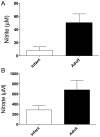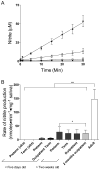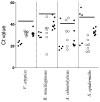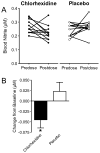Nitrate reductase activity of bacteria in saliva of term and preterm infants
- PMID: 22842223
- PMCID: PMC3466389
- DOI: 10.1016/j.niox.2012.07.004
Nitrate reductase activity of bacteria in saliva of term and preterm infants
Abstract
The salivary glands of adults concentrate nitrate from plasma into saliva where it is converted to nitrite by bacterial nitrate reductases. Nitrite can play a beneficial role in adult gastrointestinal and cardiovascular physiology. When nitrite is swallowed, some of it is converted to nitric oxide (NO) in the stomach and may then exert protective effects in the gastrointestinal tract and throughout the body. It has yet to be determined either when newborn infants acquire oral nitrate reducing bacteria or what the effects of antimicrobial therapy or premature birth may be on the bacterial processing of nitrate to nitrite. We measured nitrate and nitrite levels in the saliva of adults and both preterm and term human infants in the early weeks of life. We also measured oral bacterial reductase activity in the saliva of both infants and adults, and characterized the species of nitrate reducing bacteria present. Oral bacterial conversion of nitrate to nitrite in infants was either undetectable or markedly lower than the conversion rates of adults. No measurable reductase activity was found in infants within the first two weeks of life, despite the presence of oral nitrate reducing bacteria such as Actinomyces odontolyticus, Veillonella atypica, and Rothia mucilaginosa. We conclude that relatively little nitrite reaches the infant gastrointestinal tract due to the lack of oral bacterial nitrate reductase activity. Given the importance of the nitrate-nitrite-NO axis in adults, the lack of oral nitrate-reducing bacteria in infants may be relevant to the vulnerability of newborns to hypoxic stress and gastrointestinal tract pathologies.
2012 Elsevier Inc. All rights reserved
Conflict of interest statement
Conflicts of Interest: The authors declare no conflict of interest.
Figures






Similar articles
-
From Nitrate to Nitric Oxide: The Role of Salivary Glands and Oral Bacteria.J Dent Res. 2016 Dec;95(13):1452-1456. doi: 10.1177/0022034516673019. Epub 2016 Oct 7. J Dent Res. 2016. PMID: 27872324 Review.
-
Evaluation of bacterial nitrate reduction in the human oral cavity.Eur J Oral Sci. 2005 Feb;113(1):14-9. doi: 10.1111/j.1600-0722.2004.00184.x. Eur J Oral Sci. 2005. PMID: 15693824
-
Dietary intake and bio-activation of nitrite and nitrate in newborn infants.Pediatr Res. 2015 Jan;77(1-2):173-81. doi: 10.1038/pr.2014.168. Epub 2014 Oct 14. Pediatr Res. 2015. PMID: 25314582 Free PMC article. Review.
-
Salivary nitrite production is elevated in individuals with a higher abundance of oral nitrate-reducing bacteria.Free Radic Biol Med. 2018 May 20;120:80-88. doi: 10.1016/j.freeradbiomed.2018.03.023. Epub 2018 Mar 14. Free Radic Biol Med. 2018. PMID: 29550328
-
Effects of age, sex and diet on salivary nitrate and nitrite in infants.Nitric Oxide. 2020 Jan 1;94:73-78. doi: 10.1016/j.niox.2019.10.012. Epub 2019 Nov 2. Nitric Oxide. 2020. PMID: 31682925
Cited by
-
Nitrite-producing oral microbiome in adults and children.Sci Rep. 2020 Oct 6;10(1):16652. doi: 10.1038/s41598-020-73479-1. Sci Rep. 2020. PMID: 33024169 Free PMC article.
-
Functional mouth rinse containing inorganic nitrate and antioxidants bolsters the enterosalivary pathway and lowers blood pressure in Wistar rats.Sci Rep. 2025 Jul 23;15(1):26827. doi: 10.1038/s41598-025-12060-0. Sci Rep. 2025. PMID: 40702063 Free PMC article.
-
Changes in plasma and urinary nitrite after birth in premature infants at risk for necrotizing enterocolitis.Pediatr Res. 2016 Mar;79(3):432-7. doi: 10.1038/pr.2015.229. Epub 2015 Nov 5. Pediatr Res. 2016. PMID: 26539663 Free PMC article.
-
Potential role for age as a modulator of oral nitrate reductase activity.Nitric Oxide. 2021 Mar 1;108:1-7. doi: 10.1016/j.niox.2020.12.001. Epub 2020 Dec 13. Nitric Oxide. 2021. PMID: 33321206 Free PMC article.
-
The role of gasotransmitters in neonatal physiology.Nitric Oxide. 2020 Feb 1;95:29-44. doi: 10.1016/j.niox.2019.12.002. Epub 2019 Dec 20. Nitric Oxide. 2020. PMID: 31870965 Free PMC article. Review.
References
-
- Lundberg JO, Weitzberg E. NO-synthase independent NO generation in mammals. Biochem Biophys Res Commun. 2010;396:39–45. - PubMed
-
- Jung KH, Chu K, Ko SY, Lee ST, Sinn DI, Park DK, Kim JM, Song EC, Kim M, Roh JK. Early intravenous infusion of sodium nitrite protects brain against in vivo ischemia-reperfusion injury. Stroke. 2006;37:2744–50. - PubMed
-
- Tripatara P, Patel NS, Webb A, Rathod K, Lecomte FM, Mazzon E, Cuzzocrea S, Yaqoob MM, Ahluwalia A, Thiemermann C. Nitrite-derived nitric oxide protects the rat kidney against ischemia/reperfusion injury in vivo: role for xanthine oxidoreductase. J Am Soc Nephrol. 2007;18:570–80. - PubMed
Publication types
MeSH terms
Substances
Grants and funding
LinkOut - more resources
Full Text Sources
Medical

